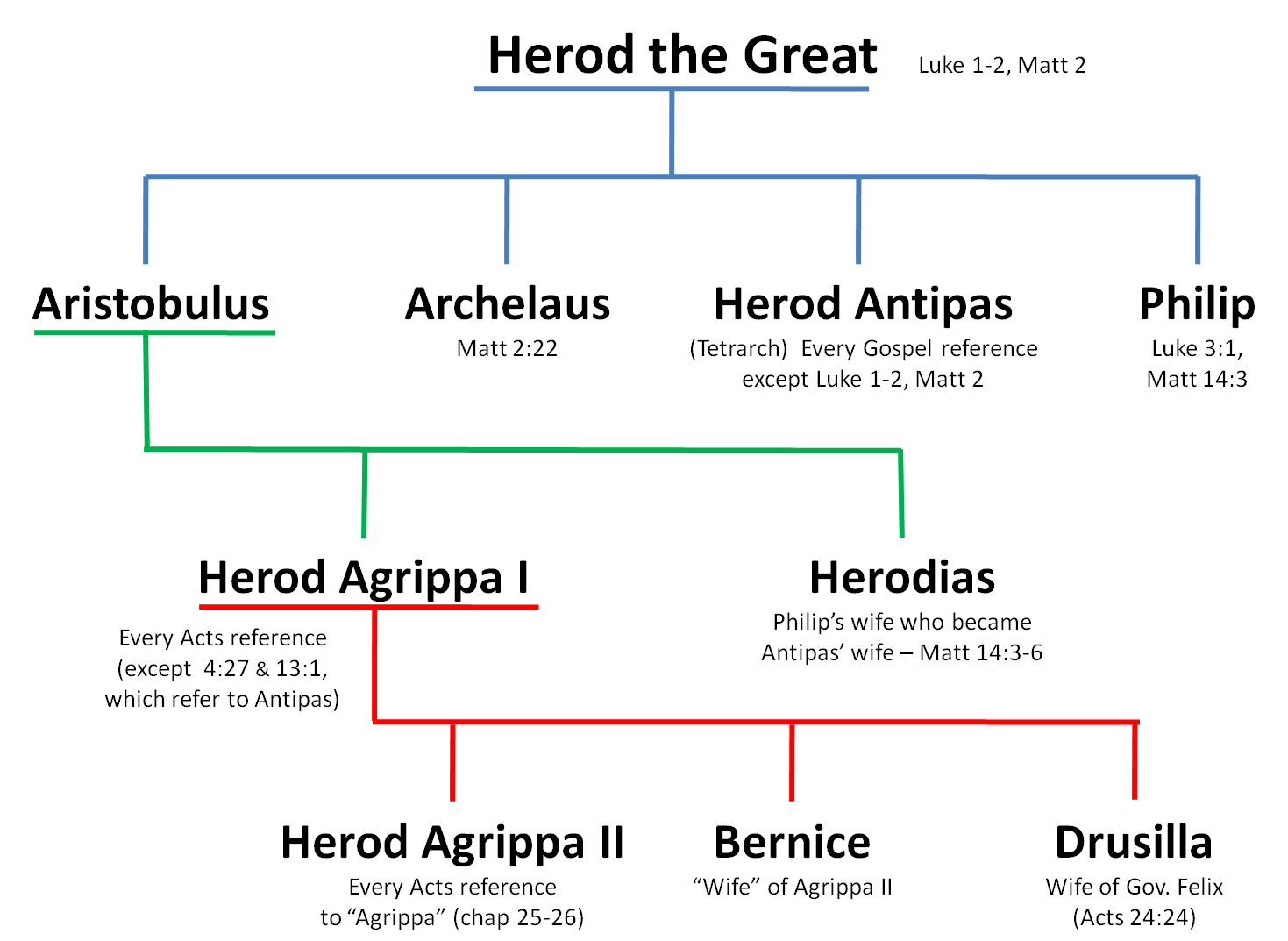Several rulers bearing the name ‘Herod’ feature in the New Testament . Chief of these was Herod the Great, from whom the other Herods took their name. The prominence of the Herods had its origins in the confusion and corruption associated with Rome’s rise to power just before the opening of the New Testament era.
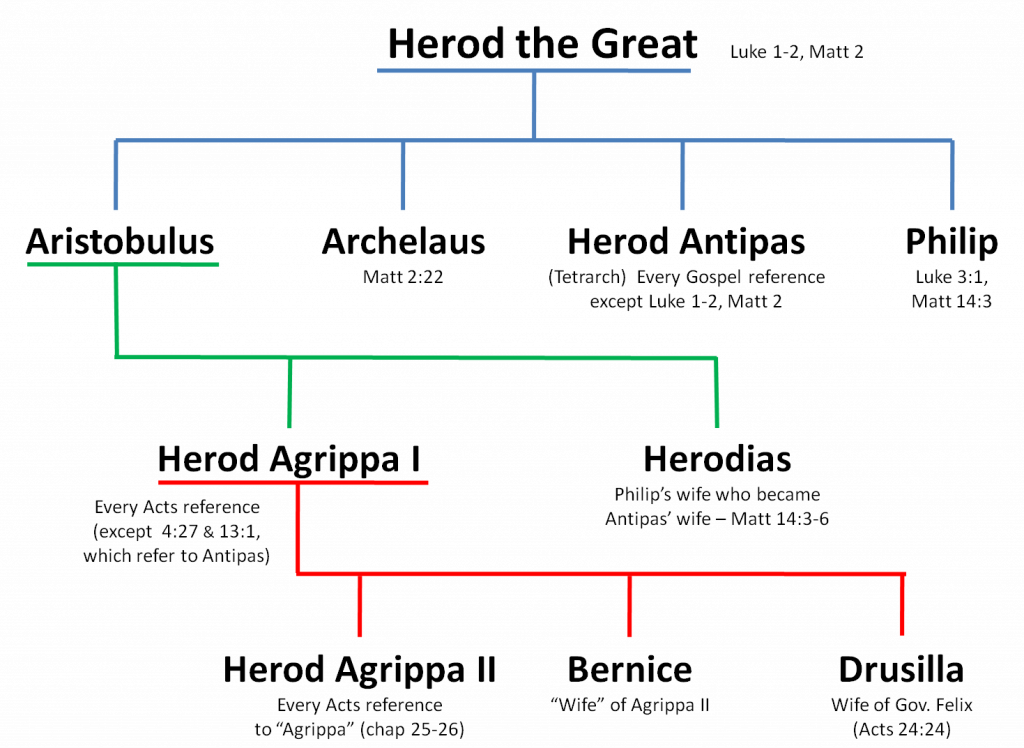
Herod the Great (72–4 BC, ruled 37-4 BC)
When Rome took control of Judea in 63 BC, it appointed as ruler a man who proved to be weak and easily used by others. He was very much under the influence of a part-Jewish Idumean friend, Antipater, who was carefully and cunningly planning to gain control himself.
In the end Antipater won Rome’s appointment as governor of Judea, with his two sons in the top positions beneath him. Throughout that period, the entire eastern Mediterranean region was troubled by power struggles and bitter conflicts, one of which resulted in Antipater being murdered and his two sons overthrown. One of these sons, who had developed even greater cunning than his father, escaped to Rome, where he persuaded the Romans to appoint him ‘king’ over the entire Palestine region. This was the person who became known as Herod the Great.
Through treachery and murder, Herod removed all possible rivals. Having made his position safe, he took firm control of Palestine and ruled it for the next thirty-three years (37-4 BC). He carried out impressive building programs, two of his most notable achievements being the rebuilding of the city of Samaria (which he renamed Sebaste) and the construction of Caesarea as a Mediterranean port. In Jerusalem he built a military fortress, government buildings, a palace for himself and a magnificent temple for the Jews ( Matthew 27:27; Mark 13:1; John 2:20; John 19:13; Acts 23:10; Acts 23:35).
In spite of Herod’s attempts to win Jewish support, the Jews hated him. This was partly because of his mixed-Jewish nationality (though he had adopted the Jewish religion) and partly because of his ruthlessness in murdering any that he thought were a threat to his position. His massacre of the Bethlehem babies was one example of his butchery ( Matthew 2:1-5; Matthew 2:13; Matthew 2:16-18).
Before he died (4 B.C.), Herod divided his kingdom among his three sons. Like their father, they could rule only within the authority Rome gave them.
The southern and central parts of Palestine (Judea and Samaria) were given to Herod Archelaus, a man as cruel as his father but without his father’s ability (Matthew 2:22). The northern part of Palestine (Galilee) and part of the area east of Jordan (Perea) were given to Herod Antipas, the man who later killed John the Baptist and who agreed to the killing of Jesus ( Mark 6:14-29; Luke 3:1; Luke 23:6-12). The regions to the north and east of Lake Galilee (Iturea and Trachonitis) were given to Philip, a man of more moderate nature than the rest of his family ( Luke 3:1). This man was half-brother to another Philip (mentioned in Mark 6:17).
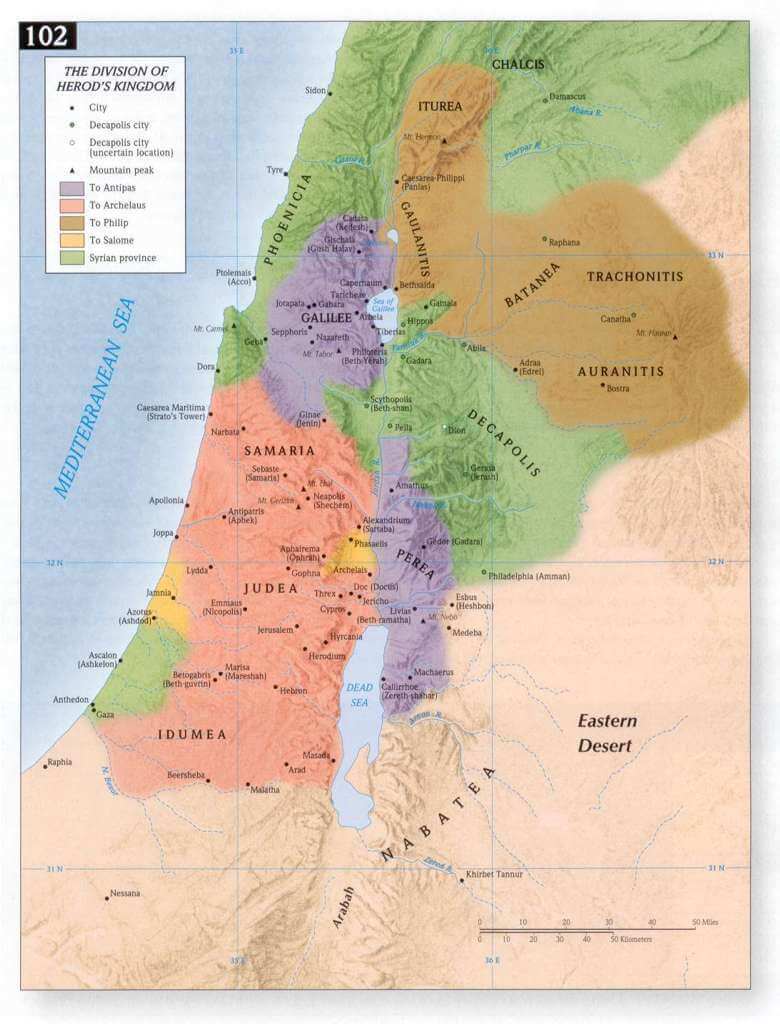
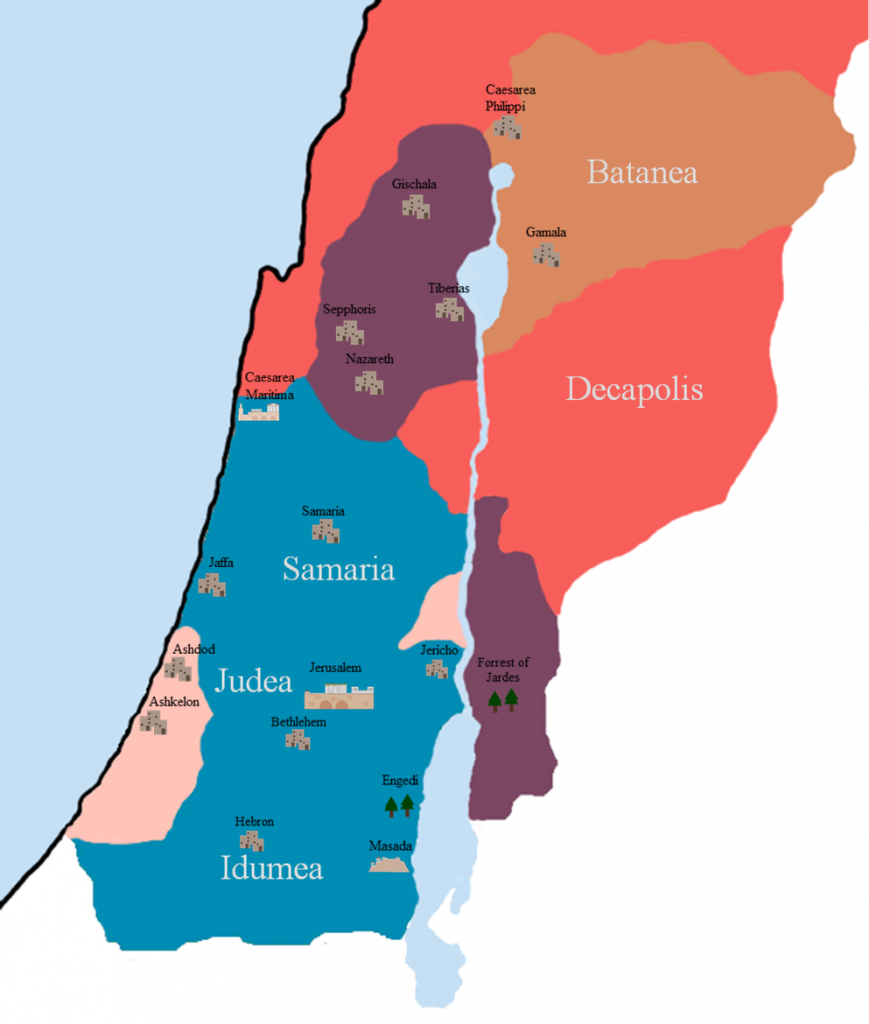
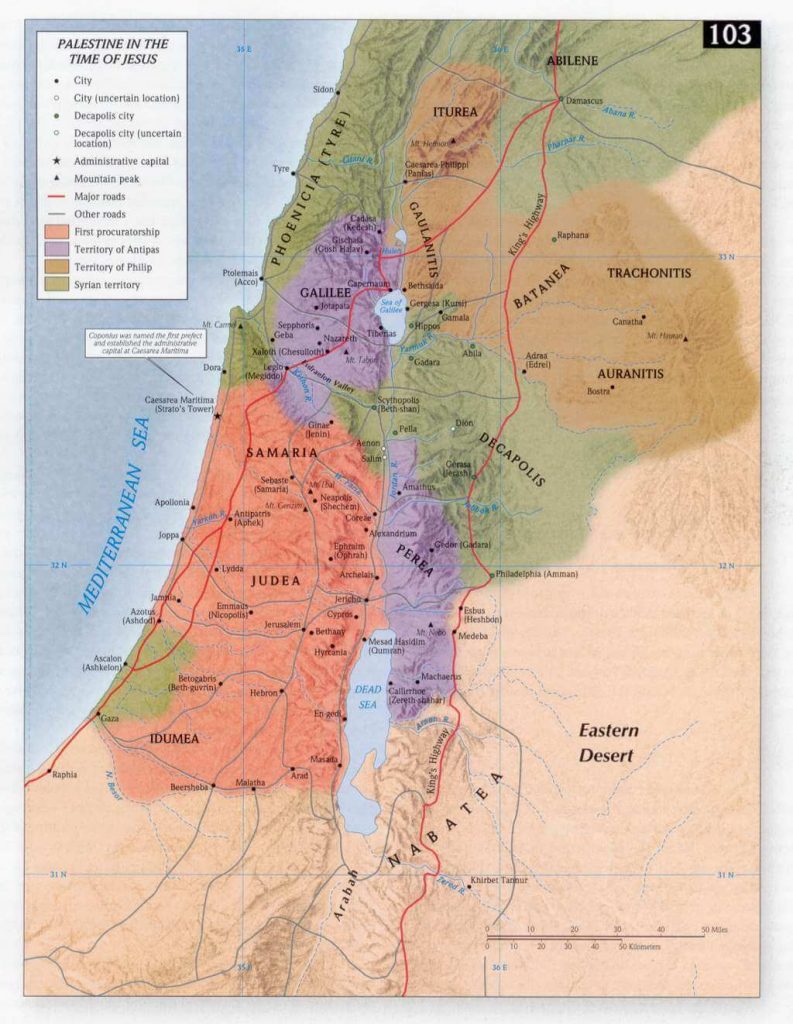
Herod Archelaus (23 B.C. – 18 A.D., ruled 4 B.C.- 6 A.D.)
Herod Archelaus was the oldest son of Herod the Great by Malthace, the Samaritan. He was a man of violent temper, reminding one a great deal of his father. He received one-half of his father’s territory, the area surrounding and near Jerusalem (Judea and Samaria).
Archelaus was so cruel and unjust that in AD 6 the people of Judea and Samaria asked Rome to remove him and rule them directly. From that time on, Judea and Samaria were governed by Roman governors (or procurators) until the destruction of Jerusalem in AD 70.
The only mention made of him in the Gospels is found in Matthew 2:22, But when he heard that Archelaus was reigning over Judea in place of his father Herod, he was afraid to go there, and being warned in a dream he withdrew to the district of Galilee.
Herod Antipas (before 20 BC – after 39 AD, ruled 4 B.C.-A.D. 39)
Herod Antipas was the son of Herod the Great by Malthace his Samaritan wife, and own brother to Archelaus, along with whom he was educated at Rome. After the death of his father, he was appointed by Augustus to be tetrarch of Galilee and Perea, that is, the southern part of the country east of the Jordan, Luke 3:1, when also the general appellation of king is sometimes given to him, Mark 6:14 . The Savior, as a Galilean, was under his jurisdiction, Luke 23:6-12.
He first married a daughter of Aretas, and Arabian king; but afterwards becoming enamoured of Herodias, the wife of his brother Herod Philip, and his own niece, he dismissed his former wife, and induced Herodias to leave her husband and connect herself with him. At her instigation he afterwards went to Rome to ask for the dignity and title of the king; but being there accused before Caligula, at the instance of Herod Agrippa, his nephew and the brother of Herodias, he was banished to Lugdunum (now Lyons) in Gaul, about A. D. 41, and the provinces which he governed were given to Herod Agrippa.
It was Herod Antipas who caused John the Baptist to be beheaded, Matthew 14:1-12 Mark 6:14-29 . He also appears to have been a follower, or at least a favorer, of the sect of the Sadducees, Mark 8:15 . Compare Matthew 16:6.
Herod Philip I (27 BC – 33/34 AD)
Philip, Mark 6:17, was the son of Herod the Great and Mariamne. He married Herodias, the sister of Agrippa I., by whom he had a daughter, Salome. He was excluded from all share in his father’s possessions in consequence of his mother’s treachery, and lived afterward in a private station.
Herod Philip II (Philip the Tetrarch, 26 BC – 34 AD, ruled 4 BC-AD 34)
Herod Philip II. was the son of Herod the Great and Cleopatra. He received, as his own government, Batanea Trachonitis, Auramtis (Gaulanitis), and some parts about Jamnia, with the title of tetrarch. Luke 3:1. He built a new city on the site of Paneas, near the sources of the Jordan, which was called Caesarea Philippi, Matthew 16:13; Mark 8:27, and raised Bethsaida to the rank of a city under the title of Julias and died there A.D. 34. He married Salome, the daughter of Herod Philip I and Herodias.
Herod Agrippa I (11 BC–44 AD, ruled 37-44 AD [41-44 in Judea])
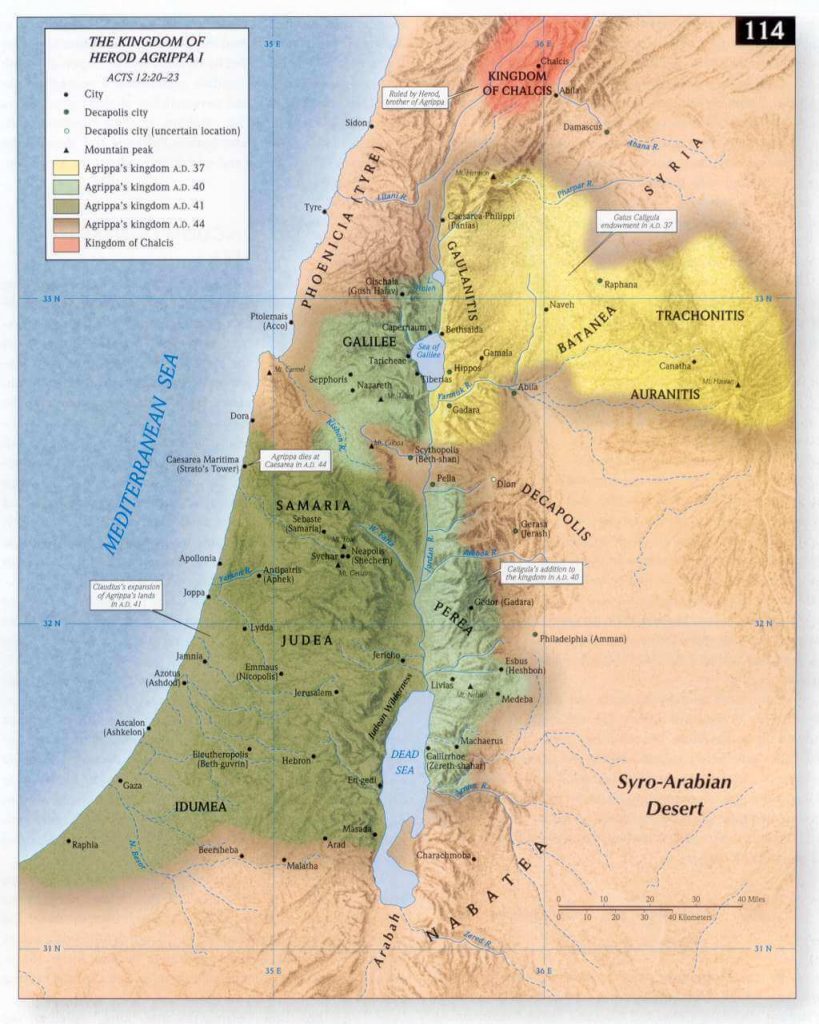
Herod Agrippa I was the son of Aristobulus and Berenice, and grandson of Herod the Great. He was brought up at Rome, and was thrown into prison by Tiberius, where he remained till the accession of Caligula, who made him king, first of the tetrarchy of Philip and Lysanias; afterward the dominions of Antipas were added, and finally Judea and Samaria. Unlike his predecessors, Agrippa was a strict observer of the law, and he sought, with success, the favor of the Jews. It is probable that it was with this view, he put to death James the son of Zebedee, and further imprisoned Peter. Acts 12:1 ff. But his sudden death interrupted his ambitious projects. Acts 12:21; Acts 12:23.
Herod Agrippa II (27–92 or 100AD, ruled AD 50s until long after the end of the Jewish war)
Herod Agrippa II was son of Herod Agrippa I, received territories in the far north of Palestine, where he served Rome loyally from AD 48 to the destruction of the Jewish state in AD 70. He was an expert on Jewish affairs and bore the ceremonial title of king, but he had no authority over the Jews of Judea ( Acts 25:13; Acts 26:3; Acts 26:27; Acts 26:31). His sisters were Bernice and Drusilla ( Acts 24:24; Acts 25:13).

Other Herods Mentioned in the Bible
Drusilla ( Acts 24:24 ) was the third and youngest daughter of Agrippa I. She had been married briefly at age 14 to Azizus, king of Emessa, probably in the year 52. In 53 or 54 she was married to Felix, the Roman procurator.
Bernice was the sister of Drusilla and Agrippa II, and also his wife. Paul appeared before them in Acts 25:1.
Salome was the daughter of Herodias. She was married to Philip. After his death in 34, she married a relative Aristobulus, prince of Chalcis and had three children ( Matthew 14:6-12; Mark 6:22-29 ).
Compiled from BiblePortal Wiki
